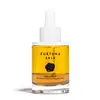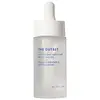What's inside
What's inside
 Key Ingredients
Key Ingredients

No key ingredients
 Benefits
Benefits

 Concerns
Concerns

No concerns
 Ingredients Side-by-side
Ingredients Side-by-side

Olea Europaea Fruit Oil
MaskingSqualane
EmollientSimmondsia Chinensis Seed Oil
EmollientOctyldodecanol
EmollientPropanediol
SolventCaprylic/Capric Triglyceride
MaskingDicaprylyl Ether
EmollientWater
Skin ConditioningGlycerin
HumectantMichelia Alba Flower Oil
MaskingOlea Europaea Leaf Water
Skin ConditioningCichorium Intybus Root Oligosaccharides
Skin ConditioningCaesalpinia Spinosa Gum
Skin ConditioningCichorium Intybus Leaf Extract
MaskingBeta Vulgaris Leaf Extract
Skin ConditioningMalva Sylvestris Leaf Extract
Skin ConditioningAsparagus Officinalis Stem Extract
Skin ConditioningHelianthus Annuus Flower Extract
Skin ConditioningMalva Sylvestris Flower Extract
Skin ConditioningAscorbyl Palmitate
AntioxidantVitis Vinifera Leaf Extract
Skin ConditioningCalendula Officinalis Flower Extract
MaskingRubus Fruticosus Fruit Water
MaskingBorago Officinalis Seed Oil
EmollientLactobacillus Ferment
Skin ConditioningEruca Sativa Leaf Extract
Skin ConditioningLamium Album Extract
AstringentPapaver Rhoeas Flower Extract
Skin ConditioningUrtica Dioica Leaf Extract
Skin ConditioningRosa Canina Fruit Extract
AstringentHypericum Perforatum Extract
AntimicrobialSodium Benzoate
MaskingPotassium Sorbate
PreservativeGluconolactone
Skin ConditioningCalcium Gluconate
HumectantCitric Acid
BufferingOlea Europaea Fruit Oil, Squalane, Simmondsia Chinensis Seed Oil, Octyldodecanol, Propanediol, Caprylic/Capric Triglyceride, Dicaprylyl Ether, Water, Glycerin, Michelia Alba Flower Oil, Olea Europaea Leaf Water, Cichorium Intybus Root Oligosaccharides, Caesalpinia Spinosa Gum, Cichorium Intybus Leaf Extract, Beta Vulgaris Leaf Extract, Malva Sylvestris Leaf Extract, Asparagus Officinalis Stem Extract, Helianthus Annuus Flower Extract, Malva Sylvestris Flower Extract, Ascorbyl Palmitate, Vitis Vinifera Leaf Extract, Calendula Officinalis Flower Extract, Rubus Fruticosus Fruit Water, Borago Officinalis Seed Oil, Lactobacillus Ferment, Eruca Sativa Leaf Extract, Lamium Album Extract, Papaver Rhoeas Flower Extract, Urtica Dioica Leaf Extract, Rosa Canina Fruit Extract, Hypericum Perforatum Extract, Sodium Benzoate, Potassium Sorbate, Gluconolactone, Calcium Gluconate, Citric Acid
Caprylic/Capric Triglyceride
MaskingSqualane
EmollientHydrogenated Ethylhexyl Olivate
EmollientDiheptyl Succinate
EmollientSimmondsia Chinensis Seed Oil
EmollientCrambe Abyssinica Seed Oil
Skin ConditioningEuterpe Oleracea Fruit Oil
Skin ConditioningHelianthus Annuus Seed Oil
EmollientVitis Vinifera Seed Oil
EmollientSclerocarya Birrea Seed Oil
HumectantPersea Gratissima Oil
Skin ConditioningCassia Angustifolia Seed Polysaccharide
Skin ConditioningArgania Spinosa Kernel Oil
EmollientBrassica Campestris Seed Oil
Skin ConditioningMoringa Oleifera Seed Oil
EmollientHippophae Rhamnoides Oil
EmollientLinum Usitatissimum Seed Oil
PerfumingOpuntia Ficus-Indica Seed Oil
EmollientSesamum Indicum Seed Oil
EmollientEmblica Officinalis Fruit Extract
Skin ConditioningCapryloyl Glycerin/Sebacic Acid Copolymer
Skin ConditioningHydrogenated Olive Oil Unsaponifiables
EmollientWater
Skin ConditioningCaprylic/Capric Triglyceride, Squalane, Hydrogenated Ethylhexyl Olivate, Diheptyl Succinate, Simmondsia Chinensis Seed Oil, Crambe Abyssinica Seed Oil, Euterpe Oleracea Fruit Oil, Helianthus Annuus Seed Oil, Vitis Vinifera Seed Oil, Sclerocarya Birrea Seed Oil, Persea Gratissima Oil, Cassia Angustifolia Seed Polysaccharide, Argania Spinosa Kernel Oil, Brassica Campestris Seed Oil, Moringa Oleifera Seed Oil, Hippophae Rhamnoides Oil, Linum Usitatissimum Seed Oil, Opuntia Ficus-Indica Seed Oil, Sesamum Indicum Seed Oil, Emblica Officinalis Fruit Extract, Capryloyl Glycerin/Sebacic Acid Copolymer, Hydrogenated Olive Oil Unsaponifiables, Water
Alternatives
Ingredients Explained
These ingredients are found in both products.
Ingredients higher up in an ingredient list are typically present in a larger amount.
This ingredient is an emollient, solvent, and texture enhancer. It is considered a skin-softener by helping the skin prevent moisture loss.
It helps thicken a product's formula and makes it easier to spread by dissolving clumping compounds.
Caprylic Triglyceride is made by combining glycerin with coconut oil, forming a clear liquid.
While there is an assumption Caprylic Triglyceride can clog pores due to it being derived from coconut oil, there is no research supporting this.
Learn more about Caprylic/Capric TriglycerideThis oil comes from the seeds of the desert shrub called Jojoba. It is more commonly known as jojoba oil, a non-comedogenic oil.
Jojoba oil does not contain fragrance and has many fatty-acids, making it a great soothing ingredient.
It also contains Vitamin E, a great moisturizing ingredient. Vitamin E is also an antioxidant and protects your skin against oxidative damage.
This ingredient humectant properties, meaning it helps draw moisture from the air. This helps keep your skin hydrated.
While jojoba has antibacterial properties, it is only able to kill some strains of bacteria.
Studies also show it helps in wound healing. In fact, Indigenous cultures have used jojoba as a moisturizer and to help treat burns for centuries.
Fun fact: Jojoba oil similar to natural human skin sebum, so it has a great effect on dry skin. It is also promising with helping to regulate sebum production.
Due to its fatty acid content, Jojoba oil may not be fungal acne safe. We recommend speaking with a professional if you have any concerns.
Learn more about Simmondsia Chinensis Seed OilSqualane is an emollient that helps the skin hold onto moisture. It's an oily liquid that occurs naturally in certain types of fish and plant oils.
Because squalane boosts hydration in the skin, it also comes with plenty of benefits: it is an antioxidant and can help fight free radicals and skin damage. Squalane is also found to have a detoxifying effect when applied.
Squalane comes from squalene, which occurs naturally within the sebum of our skin. It is one of the oils our skin produces to keep itself hydrated. Squalane is the hydrogenated version of squalene and has a longer shelf life.
Research shows that squalane is non-irritating (even at 100% concentration).
In general, it's a fantastic ingredient. It does a great job at hydrating the skin, and it's suitable for those with sensitive skin.
The source of squalane may impact malassezia / fungal acne. This is because olive oil derived squalane can contain impurities such as fatty acids and plant waxes. Sugarcane derived squalane is recommended for anyone with malassezia concerns.
Is squalane vegan?
This depends on the source. Squalane can be derived from both plants and animals. Most squalane used in skincare comes from plants.
Please note: the source of squalane is only known if disclosed by the brand. We recommend reaching out to the brand if you have any questions about their squalane.
Read more about squalene with an "e".
Is squalane an oil?
Squalane is often called an oil, but it’s technically not; it’s a hydrocarbon, meaning it’s only made of carbon and hydrogen, unlike true oils which are triglycerides made of fatty acids and glycerol.
The term “oil-free” isn’t regulated, so companies can define it however they want. Some exclude all oils, while others just avoid mineral oil or comedogenic oils.
While some people avoid oils thinking they cause breakouts, the right kind of oil (or oil-like ingredient like squalane) can actually help balance and hydrate your skin. It’s worth testing out simple oils or squalane to see what works best for your skin.
Learn more about SqualaneWater. It's the most common cosmetic ingredient of all. You'll usually see it at the top of ingredient lists, meaning that it makes up the largest part of the product.
So why is it so popular? Water most often acts as a solvent - this means that it helps dissolve other ingredients into the formulation.
You'll also recognize water as that liquid we all need to stay alive. If you see this, drink a glass of water. Stay hydrated!
Learn more about Water